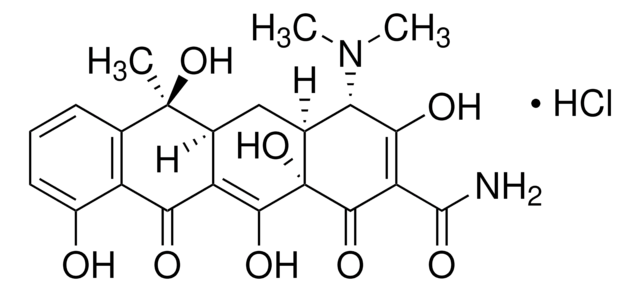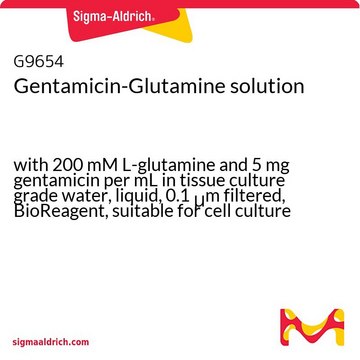Kluczowe dokumenty
G1397
Gentamicin
liquid, non-animal origin, suitable for cell culture, BioReagent
Synonim(y):
Gentamicin
About This Item
Polecane produkty
product name
Gentamicin solution, 50 mg/mL in deionized water, liquid, 0.1 μm filtered, BioReagent, suitable for cell culture
pochodzenie biologiczne
microbial
Poziom jakości
sterylność
0.1 μm filtered
linia produktu
BioReagent
Postać
liquid
siła działania
50-60 mg per mL
stężenie
50 mg/mL in deionized water
metody
cell culture | mammalian: suitable
zanieczyszczenia
endotoxin, tested
kolor
colorless to light yellow
gęstość
1.000 g/cm3
spektrum działania antybiotyku
Gram-negative bacteria
Gram-positive bacteria
mycoplasma
Tryb działania
protein synthesis | interferes
temp. przechowywania
2-8°C
ciąg SMILES
OS(O)(=O)=O.CN[C@@H]1[C@@H](O)[C@H](OC[C@]1(C)O)O[C@H]2[C@H](N)C[C@H](N)[C@@H](O[C@H]3O[C@H](CN)CC[C@H]3N)[C@@H]2O.CN[C@@H]4[C@@H](O)[C@H](OC[C@]4(C)O)O[C@H]5[C@H](N)C[C@H](N)[C@@H](O[C@H]6O[C@@H](CC[C@H]6N)[C@@H](C)N)[C@@H]5O.CN[C@H](C)[C@@H]7CC[C@@H](N)[C@H](O7)O[C@@H]8[C@@H](N)C[C@@H](N)[C@H](O[C@H]9OC[C@](C)(O)[C@H](NC)[C@H]9O)[C@H]8O
InChI
1S/C21H43N5O7.C20H41N5O7.C19H39N5O7.H2O4S/c1-9(25-3)13-6-5-10(22)19(31-13)32-16-11(23)7-12(24)17(14(16)27)33-20-15(28)18(26-4)21(2,29)8-30-20;1-8(21)12-5-4-9(22)18(30-12)31-15-10(23)6-11(24)16(13(15)26)32-19-14(27)17(25-3)20(2,28)7-29-19;1-19(27)7-28-18(13(26)16(19)24-2)31-15-11(23)5-10(22)14(12(15)25)30-17-9(21)4-3-8(6-20)29-17;1-5(2,3)4/h9-20,25-29H,5-8,22-24H2,1-4H3;8-19,25-28H,4-7,21-24H2,1-3H3;8-18,24-27H,3-7,20-23H2,1-2H3;(H2,1,2,3,4)/t9-,10-,11+,12-,13+,14+,15-,16-,17+,18-,19-,20-,21+;8-,9-,10+,11-,12+,13+,14-,15-,16+,17-,18-,19-,20+;8-,9+,10-,11+,12-,13+,14+,15-,16+,17+,18+,19-;/m110./s1
Klucz InChI
RDEIXVOBVLKYNT-HDZPSJEVSA-N
Szukasz podobnych produktów? Odwiedź Przewodnik dotyczący porównywania produktów
Opis ogólny
Zastosowanie
Gentamicin sulfate solution has been used as a component of different types of culture media.
Działania biochem./fizjol.
Antimicrobial spectrum: Includes Gram-negative and Gram-positive bacteria, including strains resistant to tetracycline, chloramphenicol, kanamycin and colistin, particularly strains of Pseudomonas, Proteus, Staphylococcus and Streptococcus.
Komponenty
Przestroga
Hasło ostrzegawcze
Danger
Zwroty wskazujące rodzaj zagrożenia
Zwroty wskazujące środki ostrożności
Klasyfikacja zagrożeń
Resp. Sens. 1 - Skin Sens. 1
Kod klasy składowania
12 - Non Combustible Liquids
Klasa zagrożenia wodnego (WGK)
WGK 2
Temperatura zapłonu (°F)
Not applicable
Temperatura zapłonu (°C)
Not applicable
Certyfikaty analizy (CoA)
Poszukaj Certyfikaty analizy (CoA), wpisując numer partii/serii produktów. Numery serii i partii można znaleźć na etykiecie produktu po słowach „seria” lub „partia”.
Masz już ten produkt?
Dokumenty związane z niedawno zakupionymi produktami zostały zamieszczone w Bibliotece dokumentów.
Klienci oglądali również te produkty
Produkty
Technologia CompoZr® ZFN generuje linie komórkowe KO do badań przenikalności leków z wykorzystaniem komórek nabłonka nerek.
Human renal proximal tubule epithelial cells (RPTECs) are commonly used to predict human renal drug permeability and to investigate drug efflux. We have generated transporter knockout (KO) cell lines using CompoZr® Zinc Finger Nuclease (ZFN) technology in a proprietary renal proximal tubule epithelial cell line.
Antibiotic kill curve is a dose response experiment in which mammalian cells are subjected to increasing amounts of selection antibiotic
Krzywa zabijania antybiotyków to eksperyment dawka-odpowiedź, w którym komórki ssaków są poddawane rosnącej ilości antybiotyku selekcyjnego.
Nasz zespół naukowców ma doświadczenie we wszystkich obszarach badań, w tym w naukach przyrodniczych, materiałoznawstwie, syntezie chemicznej, chromatografii, analityce i wielu innych dziedzinach.
Skontaktuj się z zespołem ds. pomocy technicznej






